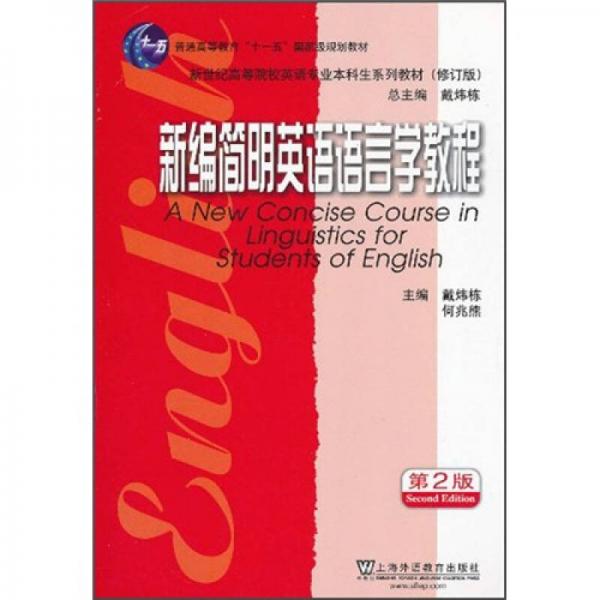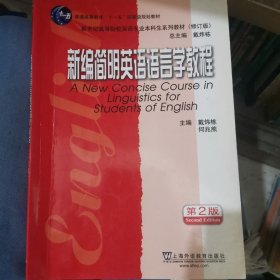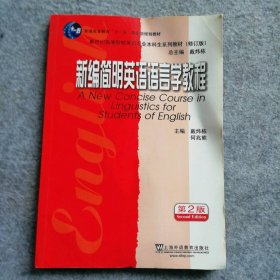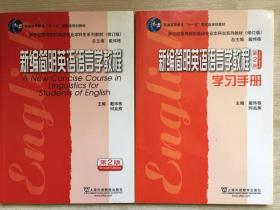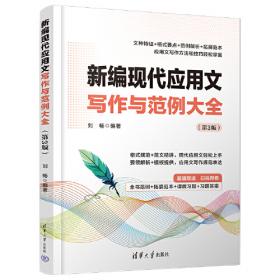新编简明英语语言学教程
出版时间:
2010-07
版次:
1
ISBN:
9787544617574
定价:
24.00
装帧:
平装
开本:
16开
纸张:
胶版纸
页数:
199页
字数:
258千字
正文语种:
英语,简体中文
-
新世纪高等院校英语专业本科生系列教材(修订版)旨在打造完整的英语专业学科体系,全面促进学生的语言技能、学科素养和创新能力的培养,必将为我国培养国际化、创新型、高素质的英语专业人才奠定坚实的基础!
权威性和先进性的体现:按照《高等学校英语专业英语教学大纲》提出的培养目标、课程设置、教学要求和教学原则精心设计,凝聚海内外英语专业教育界专家学者的智慧,反映英语专业教育、科研的最新成果。
前瞻性和创新性的结晶:基于广泛的市场调研、详尽的需求。分析和严谨的科学判断,梳理现有教程,优化教材结构,更新教学方法和手段,强化学生综合能力的培养。
专业素质和人文素养的同步提升:专业技能、专业知识、相关专业知识的完美匹配,帮助学生打下扎实的语言基本功,增强其分析问题、解决问题的能力,提高专业素质和人文素养,使学生真正成为国际化、创新型、高素质的英语专业人才。 Chapter 1 Introduction
1.1 What is linguistics?
1.1.1 Definition
1.1.2 The scope of linguistics
1.1.3 Some important distinctions in linguistics
1.2 What is language?
1.2.1 Definitions of language
1.2.2 Design features of language
1.2.3 Funcions of language
Revision exercises
For further reading
Chapter 2 Phonology
2.1 The phonic medium of language
2.2 Phonetics
2.2.1 What is phonetics?
2.2.2 Organs of speech
2.2.3 Orthographic representation of speech sounds——broad and narrow transcriptions
2.2.4 Classification of English speech sounds
2.3 Phonology
2.3.1 Phonology and phonetics
2.3.2 Phone, phoneme, and allophone
2.3.3 Phonemic contrast, complementary distribution, and minimal pair
2.3.4 Some rules in phonology
2.3.5 Suprasegmental features —— stress, tone, intonation
Revision exercises
For further reading
Chapter 3 Morphology
3.1 Introduction
3.2 Open class and closed class
3.3 Morphemes —— the minimal units of meaning
3.4 Analyzing word structures
3.5 Derivational and inflectional morphemes
3.6 Morphological rules of word formation
3.7 Derivation
3.8 Compounds
Revision exercises
For further reading
Chapter 4 Syntax
4.1 What is syntax?
4.2 Categories
4.2.1 Word-level categories
4.2.2 Phrase categories and their structures
4.3 Phrase structure rule
4.3.1 XP rule
4.3.2 Coordination rule
4.4 Phrase element,,
4.4.1 Specifiers
4.4.2 Complements
4.4.3 Modifiers
4.5 Sentences (The S rule)
4.6 Transformations
4.6.1 Auxiliary movement
4.6.2 Do insertion
4.6.3 Deep structure and surface structure
4.6.4 Wh movement
4.6.5 Move α and constraints on transformations
Revision exercises
For further reading
Chapter 5 Semantics
5.1 What is semantics?
5.2 Some views concerning the study of meaning
5.2.1 The naming theory
5.2.2 The conceptualist view
5.2.3 Contextualism
5.2.4 Behaviorism
5.3 Lexical meaning
5.3, 1 Sense and reference
5.3.2 Major sense relations
5.4 Sense relations between sentences
5.5 Analysis of meaning
5.5.1 Componential analysis ——a way to analyze lexical meaning
5.5.2 Predication analysis -a way to analyze sentence meaning
Revision exercises
For further reading
Chapter 6 Pragmatics
6.1 Some basic notions
6.1.1 Definition
6.1.2 Pragmatics vs. semantics
6.1.3 Context
6.1.4 Sentence meaning vs. utterance meaning
6.2 Speech act theory
6.2.1 Austins model of speech acts
6.2.2 Searles classification of speech acts
6. 2.3 Indirect speech acts
6.3 Principle of conversation
6.4 Cross-cultural pragmatic failure
Revision exercises
For further reading
Chapter 7 Language Change
7.1 Introduction
7.2 Phonological changes
7.3 Morphological and syntactic change
7.3.1 Addition of affixes
7.3.2 Loss of affixes
7.3.3 Change of word order
7.3.4 Change in negation rule
7.4 Lexical and semantic change
7.4.1 Addition of new words
7.4.2 Loss of words
7.4.3 Semantic changes
7.5 Some recent trends
7.5.1 Moving towards greater informality
7.5.2 The influence of American English
7.5.3 The influence of science and technology
7.6 The causes of language change
Revision exercises
For further reading
Chapter 8 Language and Society
8.1 The scope of sociolinguistics
8.1.1 The relatedness between language and society
8.1.2 Speech community and speech variety
8.1.3 Two approaches to sociolinguistic studies
8.2 Varieties of language
8.2.1 Dialectal varieties
8.2.2 Register
8.2.3 Degree of formality
8.3 Standard dialect
8.4 Pidgin and Creole
8.5 Bilingualism and diglossia
Revision exercises
For further reading
Chapter 9 Language and Culture
9.1 Introduction
……
Chapter 10 Language Acquisition
Chapter 11 Second Language Acquisition
Chapter 12 Language and the Brain
A Gloccsry in English and Chinese
References
-
内容简介:
新世纪高等院校英语专业本科生系列教材(修订版)旨在打造完整的英语专业学科体系,全面促进学生的语言技能、学科素养和创新能力的培养,必将为我国培养国际化、创新型、高素质的英语专业人才奠定坚实的基础!
权威性和先进性的体现:按照《高等学校英语专业英语教学大纲》提出的培养目标、课程设置、教学要求和教学原则精心设计,凝聚海内外英语专业教育界专家学者的智慧,反映英语专业教育、科研的最新成果。
前瞻性和创新性的结晶:基于广泛的市场调研、详尽的需求。分析和严谨的科学判断,梳理现有教程,优化教材结构,更新教学方法和手段,强化学生综合能力的培养。
专业素质和人文素养的同步提升:专业技能、专业知识、相关专业知识的完美匹配,帮助学生打下扎实的语言基本功,增强其分析问题、解决问题的能力,提高专业素质和人文素养,使学生真正成为国际化、创新型、高素质的英语专业人才。
-
目录:
Chapter 1 Introduction
1.1 What is linguistics?
1.1.1 Definition
1.1.2 The scope of linguistics
1.1.3 Some important distinctions in linguistics
1.2 What is language?
1.2.1 Definitions of language
1.2.2 Design features of language
1.2.3 Funcions of language
Revision exercises
For further reading
Chapter 2 Phonology
2.1 The phonic medium of language
2.2 Phonetics
2.2.1 What is phonetics?
2.2.2 Organs of speech
2.2.3 Orthographic representation of speech sounds——broad and narrow transcriptions
2.2.4 Classification of English speech sounds
2.3 Phonology
2.3.1 Phonology and phonetics
2.3.2 Phone, phoneme, and allophone
2.3.3 Phonemic contrast, complementary distribution, and minimal pair
2.3.4 Some rules in phonology
2.3.5 Suprasegmental features —— stress, tone, intonation
Revision exercises
For further reading
Chapter 3 Morphology
3.1 Introduction
3.2 Open class and closed class
3.3 Morphemes —— the minimal units of meaning
3.4 Analyzing word structures
3.5 Derivational and inflectional morphemes
3.6 Morphological rules of word formation
3.7 Derivation
3.8 Compounds
Revision exercises
For further reading
Chapter 4 Syntax
4.1 What is syntax?
4.2 Categories
4.2.1 Word-level categories
4.2.2 Phrase categories and their structures
4.3 Phrase structure rule
4.3.1 XP rule
4.3.2 Coordination rule
4.4 Phrase element,,
4.4.1 Specifiers
4.4.2 Complements
4.4.3 Modifiers
4.5 Sentences (The S rule)
4.6 Transformations
4.6.1 Auxiliary movement
4.6.2 Do insertion
4.6.3 Deep structure and surface structure
4.6.4 Wh movement
4.6.5 Move α and constraints on transformations
Revision exercises
For further reading
Chapter 5 Semantics
5.1 What is semantics?
5.2 Some views concerning the study of meaning
5.2.1 The naming theory
5.2.2 The conceptualist view
5.2.3 Contextualism
5.2.4 Behaviorism
5.3 Lexical meaning
5.3, 1 Sense and reference
5.3.2 Major sense relations
5.4 Sense relations between sentences
5.5 Analysis of meaning
5.5.1 Componential analysis ——a way to analyze lexical meaning
5.5.2 Predication analysis -a way to analyze sentence meaning
Revision exercises
For further reading
Chapter 6 Pragmatics
6.1 Some basic notions
6.1.1 Definition
6.1.2 Pragmatics vs. semantics
6.1.3 Context
6.1.4 Sentence meaning vs. utterance meaning
6.2 Speech act theory
6.2.1 Austins model of speech acts
6.2.2 Searles classification of speech acts
6. 2.3 Indirect speech acts
6.3 Principle of conversation
6.4 Cross-cultural pragmatic failure
Revision exercises
For further reading
Chapter 7 Language Change
7.1 Introduction
7.2 Phonological changes
7.3 Morphological and syntactic change
7.3.1 Addition of affixes
7.3.2 Loss of affixes
7.3.3 Change of word order
7.3.4 Change in negation rule
7.4 Lexical and semantic change
7.4.1 Addition of new words
7.4.2 Loss of words
7.4.3 Semantic changes
7.5 Some recent trends
7.5.1 Moving towards greater informality
7.5.2 The influence of American English
7.5.3 The influence of science and technology
7.6 The causes of language change
Revision exercises
For further reading
Chapter 8 Language and Society
8.1 The scope of sociolinguistics
8.1.1 The relatedness between language and society
8.1.2 Speech community and speech variety
8.1.3 Two approaches to sociolinguistic studies
8.2 Varieties of language
8.2.1 Dialectal varieties
8.2.2 Register
8.2.3 Degree of formality
8.3 Standard dialect
8.4 Pidgin and Creole
8.5 Bilingualism and diglossia
Revision exercises
For further reading
Chapter 9 Language and Culture
9.1 Introduction
……
Chapter 10 Language Acquisition
Chapter 11 Second Language Acquisition
Chapter 12 Language and the Brain
A Gloccsry in English and Chinese
References
查看详情
-
八品
-
八五品
湖北省孝感市
平均发货10小时
成功完成率76.41%
-
八品
河南省信阳市
平均发货1小时
成功完成率95.99%
-
八五品
湖北省孝感市
平均发货7小时
成功完成率84.63%
-
八五品
天津市武清区
平均发货13小时
成功完成率94.66%
-
八五品
广东省东莞市
平均发货7小时
成功完成率96.6%
-
八五品
广东省东莞市
平均发货12小时
成功完成率87.53%
-
八五品
陕西省西安市
平均发货3小时
成功完成率76.3%
-
八品
广东省中山市
平均发货24小时
成功完成率89.67%
-
八五品
广东省东莞市
平均发货9小时
成功完成率83.89%
-
八五品
江西省南昌市
平均发货8小时
成功完成率85.71%
-
2010-07 印刷
八五品
江西省南昌市
平均发货10小时
成功完成率100%
-
2010-07 印刷
八品
-
八五品
湖北省武汉市
平均发货9小时
成功完成率79.35%
-
八五品
福建省福州市
平均发货10小时
成功完成率98.25%
-
八五品
福建省福州市
平均发货9小时
成功完成率87.14%
-
八品
-
八五品
广东省东莞市
平均发货6小时
成功完成率55.56%
-
2011年 印刷
八品
四川省成都市
平均发货19小时
成功完成率88.2%
-
八五品
河南省郑州市
平均发货35小时
成功完成率55.56%
-
八五品
-
八五品
河南省郑州市
平均发货9小时
成功完成率68.75%
-
八五品
河北省廊坊市
平均发货17小时
成功完成率85.33%
-
八五品
-
2010-07 印刷
七品
湖北省武汉市
平均发货7小时
成功完成率88.75%
-
九品
江西省吉安市
平均发货34小时
成功完成率87.45%
-
九品
-
九五品
黑龙江省哈尔滨市
平均发货11小时
成功完成率100%

 占位居中
占位居中

